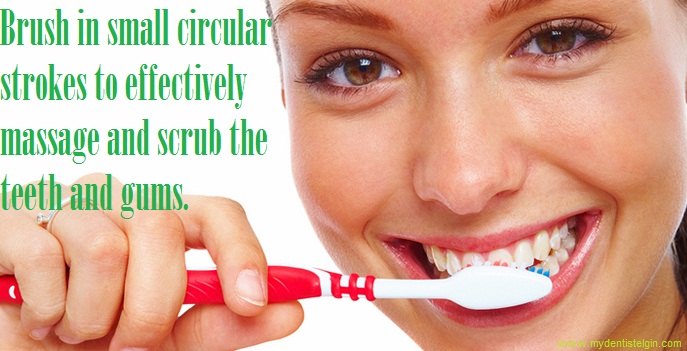1209 Dundee Avenue Elgin, IL 60120
How to Properly Brush and Floss
When a patient visits his dentist for a regular dental check-up, the appointment becomes a moment of truth because often even though the patients think that his efforts are good enough to maintain the health of his teeth, the dentist will say otherwise. “How often do you brush your teeth?”, “Do you take time to floss?”, “What kind of toothbrush and floss do you use?” These are some of the questions that your dentist will ask to find out whether you observe proper brushing and flossing techniques and practices.
You see, it is not always about the frequency of your brushing technique, but the quality of your effort. That you are brushing regularly is never a guarantee of health. Often patients would argue that they brush and floss everyday, but their habits do not exactly reflect on the condition of their oral cavity.

Take note of the following brushing and flossing tips for you to practice:
a) Proper tooth brushing
Plaque collects in the mouth on a daily basis and it actively forms as a result of bacterial combination with sugar and saliva. Ideally, one should be able to brush his teeth every time after he or she eats, but when it cannot be done, regular brushing for at least twice or thrice a day is acceptable.
Contrary to what many people believe, one is supposed to brush not following a repetitive up and down or sideward motion, but a small circular stroke. This movement effectively massages the teeth and gums, scrubbing teeth effectively, to make it smooth.
Direct the bristles of the toothbrush towards the boundary of the gums and the teeth, in a 45-degree angle. This will allow the bristles to access the sulcus, ridding the mouth of any subgingival build-up.
Effective brushing is not achieved by a hard bristled-toothbrush; in fact, this will abrade tooth structure. Toothbrushes with soft or medium bristles can very well clean your teeth.
Choose toothpaste that has very helpful components. There are properly medicated toothpastes that have ingredients that promote health and prevent disease. Some examples of ingredients to look for are: fluoride and xylitol.
b) Correct flossing
When flossing, take about 12-inches of the floss. This is sufficient length to properly access even the most posterior tooth in the mouth, with one end coiled around the index finger of one hand and the other end held by two fingers on the other.
Make sure to pass slowly from the tip of the tooth to the area by the gums, following the curvature of the one tooth and then passing the other tooth.
It does become slippery, so it would pass easily through the space in between teeth, so it is best for teeth with very tight connection with each other.
Flossing is merely an adjunct to brushing. You should floss, first, to eliminate any trapped food particles so that the teeth can be brushed more effectively, after. Since it is merely an adjunct, it is not exactly necessary for you to floss every time you brush your teeth. Doing it once a day or a few times a week is enough.
Office Hours
| Monday | 10:00 to 6:00 |
| Tuesday | 10:00 to 6:00 |
| Wednesday | 11:00 to 8:00 |
| Thursday | 10:00 to 6:00 |
| Friday | 10:00 to 6:00 |
| Saturday | 8:00 to 3:00 |
| Sunday | Appointment only |




Recent Comments